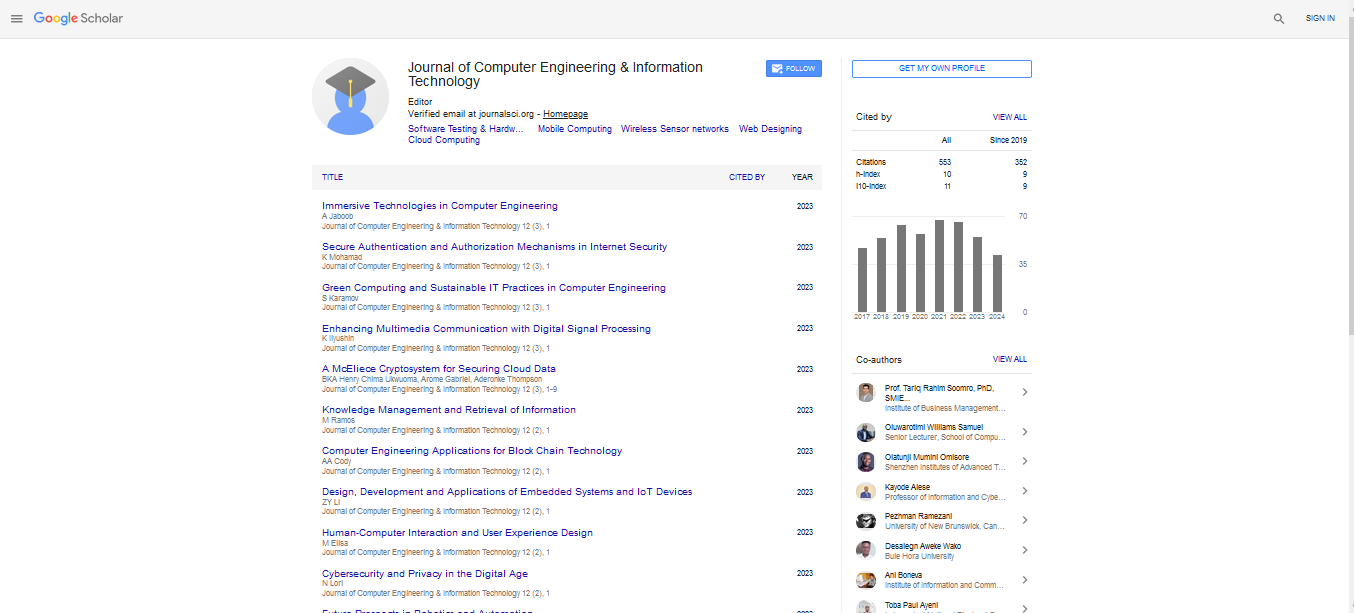Editorial, Jceit Vol: 14 Issue: 2
Web Development: Building the Digital World
Solomin T*
Training and Education Centre for Africa, University of the Free State, Bloemfontein, South Africa
- *Corresponding Author:
- Solomin T
Training and Education Centre for Africa, University of the Free State, Bloemfontein, South Africa
E-mail: solomin@gmail.com
Received: 01-March-2025, Manuscript No jceit-25-169323; Editor assigned: 4-March-2025, Pre-QC No. jceit-25-169323 (PQ); Reviewed: 20-March-2025, QC No jceit-25-169323; Revised: 27-March-2025, Manuscript No. jceit-25-169323 (R); Published: 31-March-2025, DOI: 10.4172/2324-9307.1000344
Citation: Solomin T (2025) Web Development: Building the Digital World. J Comput Eng Inf Technol 14: 344
Introduction
Web development is the process of creating websites and web applications that run on the internet or intranets. It encompasses everything from designing the look and feel of a website to building complex server-side logic that powers dynamic content and user interactions [1]. As the backbone of the modern digital landscape, web development connects businesses, individuals, and services across the globe, shaping how we communicate, shop, learn, and entertain ourselves. This article explores the fundamentals of web development, the technologies involved, popular tools, challenges, and emerging trends shaping the future of the web.
What is Web Development?
At its core, web development involves building and maintaining websites or web-based applications. It is broadly divided into three categories:
Front-End Development: Also known as client-side development, this focuses on the user interface (UI) and experience (UX). It involves creating the visual layout, design, and interactive elements using technologies such as HTML, CSS, and JavaScript.
Back-End Development: Also called server-side development, it handles the behind-the-scenes logic, databases, server configuration [2], and application programming interfaces (APIs) that support front-end features. Common back-end languages include Python, Java, PHP, Ruby, and Node.js.
Full-Stack Development: Full-stack developers work across both front-end and back-end, managing the complete lifecycle of web applications.
Key Technologies in Web Development
HTML (HyperText Markup Language)
HTML is the foundational markup language used to structure content on the web. It defines elements like headings, paragraphs, images, links, and forms.
CSS (Cascading Style Sheets)
CSS controls the visual presentation of HTML content. It manages layouts, colors, fonts, and responsiveness—ensuring [3] websites look good on all devices.
JavaScript
JavaScript adds interactivity to web pages, enabling dynamic updates without reloading. It powers things like image sliders, form validations, and real-time content updates.
Front-End Frameworks and Libraries
Popular frameworks and libraries like React, Angular, and Vue.js help developers build complex user interfaces efficiently and maintainably.
Back-End Languages and Frameworks
Back-end development uses various languages and frameworks:
Node.js: JavaScript runtime built on Chrome’s V8 engine, popular for scalable network applications.
Django: A high-level Python framework encouraging rapid development.
Ruby on Rails: An opinionated Ruby framework emphasizing convention over configuration.
Laravel: A PHP framework with elegant syntax for web development [4].
Databases
Web applications rely on databases to store and retrieve data:
Relational Databases: MySQL, PostgreSQL.
NoSQL Databases: MongoDB, Cassandra.
APIs (Application Programming Interfaces)
APIs allow web applications to communicate with other services, such as payment gateways, social media, or external databases.
Web Development Process
Creating a website or web application generally follows these steps:
Planning: Define goals, target audience, features, and site architecture.
Design: Create wireframes and prototypes, focusing on UI/UX.
Development: Code the front-end and back-end, integrate APIs and databases.
Testing: Check for bugs, performance issues, and compatibility across browsers and devices.
Deployment: Launch the site on a web server.
Maintenance: Update content, fix issues [5], and add new features.
Challenges in Web Development
Despite its accessibility, web development has challenges:
Browser Compatibility: Different browsers may interpret code differently, requiring careful testing and adaptation.
Performance Optimization: Ensuring fast load times and smooth interactions, especially on mobile devices.
Security: Protecting against threats like cross-site scripting (XSS), SQL injection, and data breaches.
Responsive Design: Making websites usable and attractive on a wide range of screen sizes.
Keeping Up with Technology: Web development is rapidly evolving, demanding continuous learning.
Emerging Trends in Web Development
The web development landscape is constantly evolving. Some current trends include:
Progressive Web Apps (PWAs): Web applications that provide a native app-like experience, including offline access and push notifications.
Single Page Applications (SPAs): Websites that dynamically update content without full page reloads, improving user experience.
Serverless Architecture: Using cloud services to run backend code without managing servers.
Artificial Intelligence Integration: Chatbots, personalized content, and voice interfaces embedded into web apps.
Motion UI: Using animations and transitions to create engaging and intuitive interfaces.
Conclusion
Web development is a vital discipline shaping how we interact with the digital world. From simple blogs to complex e-commerce platforms and real-time web applications, the skills and technologies involved continue to grow in sophistication. As businesses and individuals increasingly rely on online presence, web development remains an exciting, dynamic field with opportunities for innovation and creativity. Staying current with emerging technologies and best practices is essential for anyone looking to build effective, secure, and user-friendly web experiences.
References
- Forrester Research. (2023). The Forrester Wave: Low-Code Development Platforms.
- Gartner. (2024). Market Guide for Low-Code Application Platforms.
- Mendix. (2023). What is Low-Code?
- OutSystems. (2023). No-Code vs Low-Code: Understanding the Differences.
- TechRepublic. (2023). The benefits and challenges of low-code/no-code platforms.
Indexed at, Google Scholar, Crossref
Indexed at, Google Scholar, Crossref
Indexed at, Google Scholar, Crossref
Indexed at, Google Scholar, Crossref
 Spanish
Spanish  Chinese
Chinese  Russian
Russian  German
German  French
French  Japanese
Japanese  Portuguese
Portuguese  Hindi
Hindi 